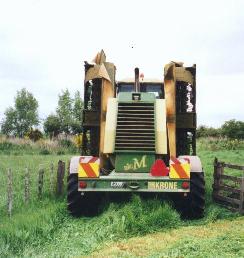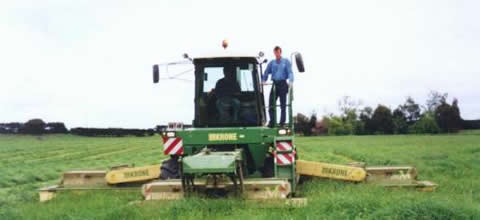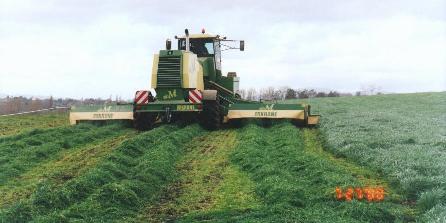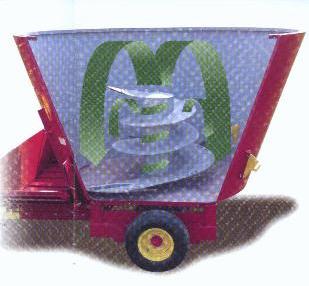Users Feedback
Four users comment on their experiences with the KRONE VarioPack
Krone VarioPack The Krone VarioPack round baler has completed its 2nd season in New Zealand and it has lived up to its reputation as the No 1 baler in Germany (where it enjoys 30% market share).
This is the baler that will continue to bale in difficult conditions where others give up - and because of it’s variable chamber, it will roll consistent, high density bales with an even PTO load and use less power. We have had a lot of positive feed back from our customers - examples follow.
Trevor and Elly Lalich, Waitoa - Owner of VP1500 MC 1st season 17,000+ bales 2nd season 13,500 bales (with new machine).
“You can just go out in the morning and bale, and that’s it ; you don’t have any problems. And it will bale anything.”
Alister Mulligan, Fairlie - Owner of VP1500 MC with tandem axle, hydraulic brakes 1st season 6,500 bales
“The only downtime was filling up the tractor (with diesel) and greasing the baler. Hell, it can even bale up chickens.”
Vince Daly, Cheviot - Owner of VP1500. 1st season 6,000 bales commented - “My 17 year old daughter has been driving the baler, and that says something about how easy it is to use. It has had less downtime than my old baler. We only had to rebale 2 or 3 bales all season and that was not the machine’s fault.”
Brian Tucker, Greytown - Owner of VP1800 MC with tandem axle. 1st season 4, 000 bales — 2nd season 5,000 bales. “We are very pleased with the performance of the machine. It produces good bales whether it be silage, hay or straw. We have had numerous comments on how well the bales are made."
"The tandem axle has been very beneficial in stopping the baler from sinking on soft ground. It smooths out the bumps and ruts on rough areas, and because of the wide track it allows us to operate with confidence on steeper sidlings.”
BIG-M Trials
"A very successful first season trial for the biggest mower conditioner in New Zealand and the World!"
Andrew Tulloch Contracting puts the KRONE BIG-M through its paces.
In line with our policy of testing major machines in NZ conditions before presenting them to the market, last year we supplied
BIG-M Trials
"A very successful first season trial for the biggest mower conditioner in New Zealand and the World!"
Andrew Tulloch Contracting puts the KRONE BIG-M through its paces.
In line with our policy of testing major machines in NZ conditions before presenting them to the market, last year we supplied Andrew Tulloch Contracting with the first BIG-M self-propelled mower conditioner. Our agreement with Andrew for testing new gear gives us first hand knowledge on field performance, mechanical reliability, and also gives our service department valuable experience in setting up and servicing the machines.
The BIG-M’s capacity in the field was certainly impressive. Strangely enough, the difference in capacity between the BIG-M and trailed mower conditioners was especially noticeable in the smaller paddocks where BIG-M’s manoeuvrability reduced field loss time by over 10%.
Transport speed
The BIG-Ms high road speed (actual speed 43 km/hr) and narrow transport width also reduced transport loss time considerably when shifting from farm to farm. This improved efficiency was not only found on the roads but also down farm tracks and negotiating narrow gateways. The result was more acres cut per day. Contracting with the first BIG-M self-propelled mower conditioner. Our agreement with Andrew for testing new gear gives us first hand knowledge on field performance, mechanical reliability, and also gives our service department valuable experience in setting up and servicing the machines.
The BIG-M’s capacity in the field was certainly impressive. Strangely enough, the difference in capacity between the BIG-M and trailed mower conditioners was especially noticeable in the smaller paddocks where BIG-M’s manoeuvrability reduced field loss time by over 10%.
Transport speed
The BIG-Ms high road speed (actual speed 43 km/hr) and narrow transport width also reduced transport loss time considerably when shifting from farm to farm. This improved efficiency was not only found on the roads but also down farm tracks and negotiating narrow gateways. The result was more acres cut per day.

Despite its size, a tight squeeze is not a problem for the BIG-M.
Mechanically sound
Overall the machine has given very little mechanical trouble, with the only failure occurring in the front mower PTO shaft. Dirt and grass gum had built up between the 2 sliding shields and eventually caused the nylon bearing to overheat. The problem was simply overcome by turning the PTO shaft end for end, so that the outer shield was facing the other way. An upgrade to the driveline was issued by Krone during the season.
Fitting the upgrade put the BIG-M out of action for 36 hours and in that period it was replaced by 2 each 2.8m mower conditioners. An additional driver had to be found at short notice and in order to keep up with the forage harvester and balers, these trailed machines had to be operated 24 hours a day and at higher than recommended mowing speeds.
The exercise highlighted the true capacity and inherent logistical advantage of the BIG-M.

John Tulloch (standing) and Aidan Mahony (driving) admire the view from the KRONE BIG-M!
Contractors lifesaver!
We asked Andrew Tulloch for his comments. Andrew said “Our tillage season started 6 weeks late due to an excessively wet and cold spring. This meant that the grass silage season started in full swing before all the crops were sown. In order to get the crops in on time, all available tractors were working maximum hours preparing ground and sowing crops.”
“Before the BIG-M, with a season like we’ve had, it would have been impossible to meet our target dates of sowing crops and harvesting silage on time. We wouldn’t have had enough tractors or experienced operators available. The BIG-M saved my bacon this year. It certainly exceeded my expectations, and played a major role in assisting us to meet our target dates in a difficult season.”
“Not only did we save time on the road with the faster transport speed, but we also saved time | in the field. On our best day we cut over 180 acres on 3 different farms and in 14 different paddocks, including approximately 30 km of travelling between jobs.”
Capacity
The spot rate for the BIG-M travelling 10 km/hr is 22.5 acres per hour (9 ha/hr). Andrew achieved 180 acres a day in his conditions. Our calculations show the BIG-M makes financial sense for a contractor mowing 4000 acres or more.
FREE OFFER - If you would like to try the same calculations on your existing equipment, give us a call for a FREE calculation sheet for any machine you own or operate!
KRONE trial in Germany
A Krone trial in Germany with a standard production machine achieved 785 acres (314 ha) in one 24 hour period. That's an average of nearly 33 acres per hour!

The KRONE BIG-M back at work.
Supreme Mixer Feeder
Runs supreme for owner Alister Jordan An interview by Philip O'Neale
On 3rd November last year I visited Alister Jordan and his farm manager Wal to get their opinions on the Supreme 500 (425 cubic feet = 12 cubic m) mixer-cutter-feeder (referred to as the mixer hereafter) that Alister purchased in September 2000.
Just in a short space of time I noticed their enthusiasm and excitement about the machine. Before we could even sit down with a cup of coffee Alister had already run through all the positives about the mixer.
Before investing in the mixer, Alister and Wal used a silage wagon with a modified side-feed and had to do a lot of the loading by hand (spreading out the straw etc.) which was time consuming and labour intensive. Apart from loading there was also the fact that it always required unblocking or repairing.
Better production and animal health
Alister milks 430 cows and already Alister & Wal have noticed a difference in the production, and animal health is better. This is attributed to the fact that the cows are all getting the right amount of supplements in each mix.
At present Alister is using only one tractor for the whole operation. The system really needs 2 tractors, one to load while the other runs the mixer during loading.
At the moment Alister loads the mixer and then hooks up the mixer and mixes the load which takes approximately 8 minutes to get an even blend. The mixing time can vary depending on the ratio of straw used in the mix. They have also noticed that the knives definitely cut the straw.

Alister is so confident now on how well the Supreme mixes that he is happy to add DAP into the mix when required as well as any other supplements and he knows it will be evenly distributed through the mix with no lumps. Wal uses the Supreme mixer-feeder 98% of the time and is very happy with the job it is doing so far. He is doing 2 mixes per day on average but this varies throughout the year.
What changes if any have you noticed in the animals?
“When mixing a large amount of maize with the straw and other supplements we have noticed that the cows have to eat the whole lot because the straw is mixed evenly throughout and the cows cannot pick and choose what they eat. This is evident in their manure.”
Have you noticed any difference in the amount of wastage?
“Yes, having load scales on the mixer has saved on feed as now we know exactly how much we are adding to each mix.”
Compared to your earlier method of feeding have you found any differences?
“Yes, it requires less man power (energy) as now there is no manual labour for loading the mix, no need to break up and spread out the straw or sprinkle supplements over the load.”
How have you found the Supreme mixer to operate?
“It is very easy to operate but you need to be aware of the unloading chute sticking out the side. The mixer can turn sharper than the silage wagon and it is very easy to manoeuvre around the yard.”
What made you decide to buy the Supreme?
“It’s simplicity, with no chains it is hassle-free and easy to maintain (low maintenance). The unloading chute is short and gives a good even spread and you have full control on the amount of mix that gets unloaded. It is built strong and should last a very long time.”
Alister says that the only down side for a smaller dairy farm is that you really need 2 tractors but as Alister is proving, you can get away with one larger tractor to do the job. But in the end Alister’s comment was that he is very happy with his decision on the purchase he made. “If you want to make the right job then it pays to buy the machine that is designed to do it.”
Both Alister and Wal are very positive. Tulloch Farm Machines intends to hold a small field day on Alister’s property near New Plymouth. More information about this will be advised later. TFM comments!
Unlike standard feed mixers, the Supreme, in addition to doing a first rate job of mixing, can take any amount of hay or straw including a whole uncut balage bale. It can cut up bales and mix them into maize silage, crushed grain or meal. This machine gives the farmer the opportunity to mix whatever feeds are available from time to time, and doesn't limit itself to chopped silage, meal and a little hay or straw.

.png)